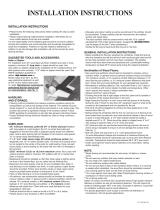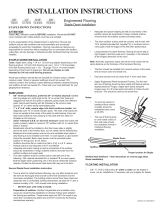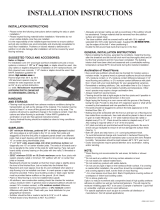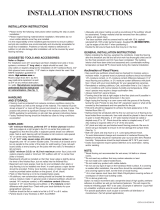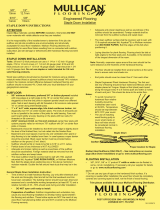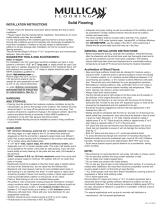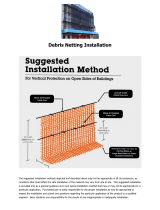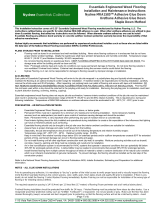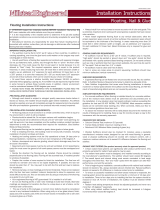Page is loading ...

The limited warranties set forth below apply only to pre-finished products and are effective with
purchases made after November 7, 2016. All warranties are limited to the original purchaser only.
FINISH WARRANTY
Flooring manufacturer warrants that the finish will not wear through to the wood for 50 years.
Please refer to the Finish Warranty Chart or to the individual product brochure for more
information on your particular product. EXCLUSIONS AND LIMITATIONS DO APPLY. SEE
BELOW FOR DETAILS.
MATERIAL WARRANTY
Flooring manufacturer warrants that the products have been manufactured in compliance with the
grading rules of flooring manufacturer, and will be free from manufacturing defects for as long as
the original purchaser owns the floor. Manufacturing defects do not include natural wood
characteristics such as mineral streaks, knots, grain variations, normal minor differences between
color of samples and the color of installed floors, color variations from board to board, or minor
width variation. Due to the nature of wide width plank (3” and wider), some minor width variation
is to be expected and is not considered a defect.
EXCLUSIONS AND LIMITATIONS
These warranties do not cover damage, indentations, scratches, or stains arising from negligence,
accidents, abuse, fire or excessive heat, abnormal wear, construction, spike heels, grit, sand or
other abrasives, dents, insect infestation after the product has left our factory, or domestic animals.
Splits and cracks after move-in are not normally manufacturer related.
These warranties do not cover damage caused by use of the flooring for purposes other than those
for which it was designed; damage caused by disasters such as fire, flood, wind, and lightning;
damage during shipment; or any other abuse or misuse by the purchaser.
It is critical that all installations are done in compliance with the procedures outlined in the
flooring manufacturer installation instructions, which can be found in each carton of flooring. No
damage or defects caused by improper installation or failure to provide a suitable installation
environment are covered by this warranty. Failure to install your flooring in accordance with the
instructions will void all warranties.
The sole obligation and liability of flooring manufacturer under our limited warranties is to repair,
replace, or refinish the floor, at flooring manufacturer’s option. Only floors that were profession-
ally installed will be eligible for labor cost reimbursement. If you installed the floor yourself, we
will cover the cost of replacement materials only. (Any and all labor costs must be pre-approved
by the flooring manufacturer’s Claims Department.)
These warranties EXCLUDE and will not pay consequential or incidental damages associated with
any warranty claim. Flooring manufacturer will not pay costs associated with relocation during the
repair process such as hotel, meals, or moving and storage of furniture. This limitation does not
apply to claims for personal injury. Some states do not allow limits on warranties, or on remedies
for breach in certain transactions. In such states, the limits in this paragraph may not apply.
No warranty coverage is provided for flooring that contains obvious defects of any kind that were
installed nonetheless. If, before installation, you discover any flooring that has obvious defects,
please immediately contact the dealer from whom the flooring was purchased and replacement
flooring will be provided at no cost.
Only flooring manufacturer approved cleaning products are appropriate for use on flooring
manufacturer’s products. Use of non-flooring manufacturer approved cleaning and maintenance
products, including oil soap or ammonia based products, will void all warranties. For a current list
of approved products, please call your local dealer, or wood distributor.
The limited warranties do not cover color changes to any flooring which results from exposure to
UV light. Normal exposure to sunlight will cause changes in the shading of any wood floor, and
this is not considered a defect. Certain species including, but not limited to, American Cherry,
Walnut, Brazilian Cherry, Tigerwood, and most Exotics, are especially susceptible to color change.
Please contact your flooring retailer for more information. Area rugs should be moved occasion-
ally, as they block sunlight and may give the appearance of discoloration under the rug.
After your floor is installed, it is critical to maintain the temperature and humidity of the home
within the ranges set forth in the applicable installation instructions for the product. Failure to
follow these guidelines, especially with regard to humidity range, can result in a performance
failure or damage to your floor. In addition, it is important to maintain your floor in accordance
with the flooring manufacturer’s maintenance instructions which can be found in the flooring
manufacturer maintenance flyer.
These warranties do not cover damage or unsatisfactory performance caused by excessive
moisture or moisture vapor including, but not limited to, improper humidity inside the home,
excessive ground moisture that migrates into the home for any reason, excessive sub-floor
moisture, water leaks caused by broken pipes or appliances, improper cleaning methods such as
wet mopping or automated cleaning machines, weather conditions or natural disasters such as
flooding or excessive rainfall.
Since wood is a natural product, it will tend to expand and contract as moisture and humidity
levels inside the home may change. Accordingly, normal expansion and contraction which results
in minor separations between flooring boards are not covered by these warranties.
Any flooring manufacturer product which is designated as “cabin grade”, “tavern grade”,
“second”, or “as is” is not covered by the above warranties.
THERE ARE NO WARRANTIES WHICH EXTEND BEYOND THE DESCRIPTION ON THE
FACE HEREOF, OR AS OTHERWISE SET FORTH HEREIN. NO OTHER WARRANTIES,
EXPRESSED OR IMPLIED, BY OPERATION OF LAW OR OTHERWISE ARE MADE,
INCLUDING BUT NOT LIMITED TO, MERCHANTABILITY OR FITNESS FOR A
PARTICULAR PURPOSE. UNDER NO CIRCUMSTANCES SHALL FLOORING MANUFAC-
TURER BE LIABLE FOR ANY LOSS OR DAMAGE ARISING FROM THE PURCHASE,
USE, OR INABILITY TO USE THIS PRODUCT, FOR ANY SPECIAL, INDIRECT, INCIDEN-
TAL OR CONSEQUENTIAL DAMAGES. SOME STATES DO NOT ALLOW LIMITATIONS
ON HOW LONG AN IMPLIED WARRANTY LASTS, OR THE EXCLUSION OR LIMITA-
TION OF INCIDENTAL OR CONSEQUENTIAL DAMAGES, SO THE ABOVE LIMITATIONS
MAY NOT APPLY TO YOU. THIS WARRANTY GIVES YOU SPECIFIC LEGAL RIGHTS.
YOU MAY ALSO HAVE OTHER RIGHTS WHICH VARY FROM STATE TO STATE. YOUR
RIGHTS AND THE LIMITATIONS DESCRIBED ABOVE VARY FROM STATE TO STATE.
THUS, IT IS IMPORTANT TO RETAIN THIS WARRANTY INFORMATION. NO
INSTALLER, RETAILER, DISTRIBUTOR, AGENT, OR EMPLOYEE OF FLOORING
MANUFACTURER HAS THE AUTHORITY TO INCREASE OR ALTER THE OBLIGATIONS
OR LIMITATIONS OF THIS WARRANTY.
HANDLING OF CLAIMS
UNDER THIS WARRANTY
Claims must be filed within the coverage period, and information verifying the date of purchase
may be required. Flooring manufacturer reserves the right to have a designated flooring
manufacturer representative inspect the floors and remove samples for technical analysis.
If you need to file a claim under this warranty, first contact your flooring manufacturer retailer. If
for some reason, your retailer is unable to satisfy your claim, you may contact us at:
Flooring Manufacturer, Claims Department, P.O. Box 3549
Johnson City,
Tennessee 37602.
Any and all disputes arising out of the purchase of flooring manufacturer products or this warranty
shall be subject to mandatory and binding arbitration in Johnson City, Tennessee, pursuant to the
rules of the American Arbitration Association. Any trials by jury are expressly waived.
FLOORING MANUFACTURER SOLID AND ENGINEERED
PRODUCT FEATURES
_______________________________________________________________________________
PRODUCT PAD & SAND & INSTALL OVER WHERE TO
RECOAT REFINISH * RADIANT HEAT INSTALL
_______________________________________________________________________________
SOLID YES YES NO ON GRADE
ABOVE GRADE
_______________________________________________________________________________
ENGINEERED YES YES YES ON GRADE
(OAK ONLY) ABOVE GRADE
BELOW GRADE
*If your floor is sanded down to the bare wood and a new finish is applied, all finish warranties
must be assumed by the finish manufacturer.
50
YEAR
LIMITED RESIDENTIAL WARRANTY PROGRAM
PREFINISHED HARDWOOD FLOORING
Gen-E-50
(
11/7/2016)

STAPLE DOWN INSTRUCTIONS
Notes:
Staple Down
Proper location for Staple
3/8" 1/2"
10mm 12.7mm
Engineered Flooring
Staple Down Installation
ATTENTION
Inspect ALL materials carefully BEFORE installation. Warranties DO NOT
cover materials with visible defects once they are installed.
It is the responsibility of the installer/owner to determine if the job site
subfloor and job site conditions are environmentally and structurally
acceptable for wood floor installation. Flooring manufacturer declines any
responsibility for wood floor failure resulting from or connected with subfloor,
subsurface, job site damage or deficiencies after hardwood flooring has been
installed.
STAPLE DOWN INSTALLATION
Tools: Staple down using 1 1/4 to 1 1/2 inch long staples depending on the
flooring product. (1/2 inch thick flooring can use 1 1/4 or 1 1/2 long staple ,
9/16 thick flooring should use 1 1/2). 18 gauge 7/32 or 1/4 crown staples
depending of the brand of staple gun. Do not use staples or nails
intended for 3/4 inch solid flooring products.
Wood type subfloors should also be checked for moisture using a reliable
moisture meter. Wood or plywood subfloors should not exceed 14%
moisture content, the moisture content difference between hardwood flooring
and subfloor should not exceed 4%. Check with your local distributor for your
geographical variances.
SUBFLOOR:
• 5/8” minimum thickness, preferred 3/4” or thicker plywood installed
with long edges at a right angle to the 16” on center floor joists and
staggered so that the end joints in adjacent panels break over different
joists. Nail at each bearing with 6d threaded or 8d common nails
spaced 10” on center along intermediate joists.
• 1” x 4” to 6” wide, square edge, kiln dried coniferous lumber, laid
diagonally over 16” on center wooden joists. The ends of all boards are
to be cut parallel to the center of the joists for solid bearing. Face nail
each board solidly at every bearing on the joists with two nails (7d
threaded or 8d common).
• 23/32” minimum O.S.B. on 19.2-inch minimum center floor joists with
system properly nailed or minimum 7/8” subfloor with 24” on center floor
joists or trusses.
• Baseboards should be installed so that their lower edge is slightly
above the level of the finished floor, but not nailed into the finished floor.
• Basement and crawl spaces must be dry and ventilated when plank or
strip flooring is to be installed over them. In crawl spaces a vapor barrier
should be provided. Black vapor barrier must be provided below
subfloor on the ground. (6 mil. black)
• Subfloor should be flat or made to be flat to 3/16” in a 8’ ft. radius.
• Particle board of any thickness is NOT ALLOWED!
• Adequate and proper nailing as well as soundness of the subfloor
should be ascertained. Foreign material shall be removed from the
subfloor surface and swept clean.
• The clean subfloor shall be covered wall to wall with one of the
following: 15lb. asphalt saturated felt, or Aquabar
®
B (no rosin paper).
Butt the edges when positioning one or the above mentioned moisture
retarder. Double the felt around heat ducts that may be in the floor.
General Staple Down Installation Instruction:
• Time at which to install hardwood flooring: Lay only after sheetrock and
tile work are thoroughly dried and all but the final woodwork and trim
have been completed. The building interior should have been dried and
seasoned and a comfortable working temperature (at least 60° F) and a
relative humidity of 35 – 55% should exist during installation.
• DO NOT open until ready to install.
Preparation of subfloor: Subfloor irregularities and undulation may
cause any wood flooring installation to develop hollow spots between
the flooring and subfloor. These hollow spots are NOT the result of any
wood floor manufacturing defect and are NOT covered by the flooring
manufacturer warranty.
• To avoid movement in
hardwood floor relative
humidity should be
maintained year round
at 35-55%
• The use of flooring putty
to cover small cracks or
face nail holes should
be considered normal in
hardwood flooring
installation.
Radiant Heat Subfloors – See instructions on reverse page (Glue
Down Installation)
FLOATING INSTALLATION
• 3/8” or ½” product 5” width or wider can be floated in some, not
all, installations. If necessary call your supplier for details.
INSTALLATION INSTRUCTIONS
• Adequate and proper stapling as well as soundness of the
subfloor should be ascertained. Foreign material shall be
removed from the subfloor surface and swept clean.
• The clean subfloor surface shall be covered, wall to wall, with
15 lb. asphalt saturated felt, Aquabar
®
B, or moisture mat (no
rosin paper). Butt the edges of this felt when positioning it.
• Laying direction for plank flooring: Flooring should be laid at
right angles to the floor joists and, if possible, in the direction
of the longest dimension of the room.
Note: Normally, expansion space around the room should be the
same distance as the thickness of the hardwood flooring.
• The floor should be installed from several cartons at the same
time to ensure color and shade mix.
• End joints should never be closer than 4” from each other.
• Staple Engineered Plank Hardwood Flooring: The first and
last row of flooring should be face nailed and filled,as well as
staples placed at Tongue. Staple each board along the
tongue every 4 to 6 inches apart and within 2 inches of each
end joint. This should be done to the entire floor.
GEN
-E-50
(
11/7/16)

Engineered Flooring
Glue Down Installation
GLUE DOWN INSTRUCTIONS
ATTENTION
Inspect ALL materials carefully BEFORE installation. Warranties DO NOT cover
materials that are installed with visible defects.
It is the responsibility of the installer/owner to determine if the job site Subfloor and
job site conditions are environmentally and structurally acceptable for wood floor
installation. Flooring manufacturer declines any responsibility for wood floor failure
resulting from or connected with subfloor, subsurface, job site damage or
deficiencies after hardwood flooring has been installed.
GLUE DOWN INSTALLATION
ADHESIVE: Using an appropriate, quality urethane adhesive is recommended.
TOOLS: The required tools for installation of these products include a hammer,
hand power saw, chalk line, wood floor adhesive and recommended trowel.
Recommended Trowel: General ½” thick wood floor should use 3/16” wide 5/32”
deep v-notch trowel to yield approximately 45 to 50 sq. ft. per gallon or ¼” x ¼” x
3/16”square notch. 5/16” thick wood flooring should use 3/16” x ¼” x ½” contour
v-notch to yield 60 sq. ft. per gallon. Follow adhesive manufacturer’s guidelines.
General Installation Instruction:
Time at which to install hardwood flooring: Lay only after sheetrock and tile work
are thoroughly dried and all but the final woodwork and trim have been completed.
The building interior should have been dried and seasoned and comfortable
working temperature (at least 60°F) should exist during installation.
Preparation of subfloor:
Subfloor irregularities and undulation may cause any wood floor installation to
develop hollow spots between the flooring and subfloor. These hollow spots are
NOT the result of any wood floor manufacturing defect and are NOT covered by
the flooring manufacturer warranty.
As part of your subfloor preparation remove any existing base, shoe mold or
doorway thresholds. These items can be replaced after installation, but should be
replaced in such a way as to allow at least ¼” room for expansion around the
perimeter of the room. All door casings should be notched out or undercut to allow
for ¼” room expansion and to avoid difficult scribe cuts. This is easily done by
placing a piece of the engineered product on the subfloor as a height guide for your
handsaw or jamb saw.
Note: Normal expansion space around the room should be the same distance as
the thickness of the hardwood flooring.
Thoroughly clean subfloor:
Remove paint, wax, oil, plaster, “sheetrock mud” and other foreign materials, as
well as obvious surface irregularities. #3-1/2 grit open coat paper may need to be
used to grind a concrete subfloor. This will loosen any dirt, loose concrete or
contaminates. Sweep or vacuum thoroughly. All previous or existing glues or
adhesives must be removed before installing new hardwood floor. Concrete
subfloors must be clean, flat, sound and sufficient compression strength (3000 lbs.
P.S.I.) being sure that the surface is NOT slick.
Sections not flat due to waviness, trowel marks, etc. are to be flattened by grinding
or the use of leveling compound. Especially along the walls, the subfloor flatness
must be checked and if necessary improved. Flatten to 3/16” in 10’ radius. In
addition to cement subfloors, these wood flooring products can be installed over
dry, flat subfloors such as plywood. No Particle board.
Time at which to install hardwood flooring: Lay only after sheetrock and tile work
are thoroughly dried and all but the final woodwork and trim have been completed.
The building interior should have been dried and seasoned and a comfortable
working temperature (at least 60° F) and a relative humidity of 35 – 55% should
exist during installation. If subfloor is concrete, check for dryness see below. If
moisture is present, do not lay. All concrete subfloors on or below grade need to be
tested.
Concrete subfloor Moisture Testing:
Electrical Impedance Test and Electrical Resistance Test (Concrete Moisture
Meters) Follow Moisture Meter MFG Guidelines. If Meter shows possibility of
excess moisture further testing is required. Calcium Chloride Test. See below.
Relative Humidity Test (Standard test method for determining relative humidity on
concrete floor slabs using Situ Probes. If test shows over 75% vapor retarder must
be used or wait for further curing.
Calcium Chloride Test ASTM F-1869 Readings over 3 lbs and up to 7 lbs vapor
retarder needed.
See NWFA installation guidelines chapter 3 Moisture Testing for full information of
testing.
Check floor in several locations. Consult with your local flooring distributor for
graphical variances.
Note: Normal expansion space around the room should be the same distance as
the thickness of the hardwood flooring.
• The use of flooring putty to cover small cracks or face nail holes should
be considered normal in hardwood flooring installation.
New wood type subfloors should also be checked for moisture using a moisture
meter. In general, wood or plywood subfloors should not exceed 14% moisture
content and no more than 4% MC difference between wood flooring and subfloor.
Check with your local distributor for your geographical variances. If the plywood is
used as an overlay over the existing subfloor, the thickness of the overlay material
must be such as to yield a total ¾” subfloor thickness.
Suggested Layout Working Line: EXAMPLE: For 3” Material, snap a chalk line
30 ¼” from the wall on the door side of the room. The small area will be your
working space and the last to be installed. Temporarily nail straight board on chalk
line.
Caution: Proper humidity must be controlled between 35 – 55% for successful
performance before, during and after installation.
Installing the floor:
• The floor should be installed from several cartons at the same time to
ensure color and shade mix.
• End joints should never be closer than 4 inches from each other.
• Install tongue into groove.
• Tongue and groove should be engaged by hand.
• Lift a plank periodically to check adhesive transfer.
• Remove nailed board and install remainder of flooring.
• Install base and mould after floor installation.
• Clean adhesive off surface of wood with cleaner and soft cloth. (see
adhesive manufacturer’s recommendations)
For Unfinished Products
• Do not start sanding product until adhesive has cured.
Radiant heat subfloors – See below.
Concrete or Plywood: Radiant Heat (Oak ONLY)
• Radiant Heat Subfloors on or above grade.
• The maximum temperature of subfloor under normal use should not
exceed 80°F (Check with heat system manufacturer.)
• For correct water temperature inside heating pipes, check with
manufacturer’s suggested guidelines.
• Heating pipes must be covered with 1 ¼” of concrete or minimum of
1/8” below bottom side of plywood subfloor.
• Before installation of hardwood flooring, heat system must be operated
at normal living temperature for a minimum of 14 days. One to two
days before the flooring is laid, switch off heating unit. (At time of
installation, subfloor should be 64°F to 68°F)
• Room temperature should not vary more than 15°F season to season.
Flooring manufacturer approved systems must not exceed 8 watts per
square foot heating.
3/8" 1/2"
10mm 12.7mm
INSTALLATION INSTRUCTIONS
Gen-E-50
(
11/7/16)
/
